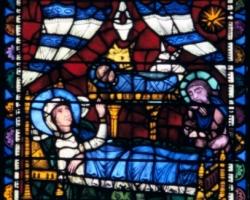The Backdrop: Christmas is near; manger scenes are all around; and there’s a good chance that some time in the next few days you’ll hear the words, “In those days Caesar Augustus issued a decree,” the beginning words of the familiar nativity story from the Gospel of Luke. Most of us know the nativity stories in Luke and Matthew, but the idea of God becoming human shows up in nearly every book of the Bible in some form or another. It’s a pretty big deal.
The Word
“And the Word became flesh and dwelt among us, and we have seen his glory, glory as of the only Son from the Father, full of grace and truth…And from his fullness we have all received, grace upon grace” (
“For there is one God and one mediator between God and human beings, Christ Jesus, himself human, who gave himself as a ransom for all people. This has now been witnessed to at the proper time” (
“For what the law was powerless to do because it was weakened by the sinful nature, God did by sending his own Son in the likeness of sinful humanity to be a sin offering…The mind controlled by the sinful nature is death, but the mind controlled by the Spirit is life and peace” (
“But when the set time had fully come, God sent his Son, born of a woman, born under the law, to redeem those under the law, that we might receive adoption to sonship. Because you are his sons, God sent the Spirit of his Son into our hearts, the Spirit who calls out, ‘Abba, Father.’ So you are no longer slaves, but God’s children; and since you are his children, he has made you also heirs” (
“For in Christ all the fullness of the Deity lives in bodily form, and in Christ you have been brought to fullness. He is the head over every power and authority” (
“This is how God showed his love among us: He sent his one and only Son into the world that we might live through him. This is love: not that we loved God, but that he loved us and sent his Son as an atoning sacrifice for our sins” (
The What
In fact, every Scripture verse above touches on the idea of God becoming human, but you’ll not see any mention of swaddling clothes or lowing cattle. What you will see are answers to What, Why and How questions related to God becoming one of us. Quite honestly, as we better understand the idea of God becoming one of us, we’ll see our personal relationship with Jesus deepen.
Each of the verses will answer at least one or more of these questions:
–What did God do?
–Why did God do it?
–How do we benefit from what God did?
You may want to print these Scripture verses, then read each verse and look for phrases that answer any of the What, Why and How questions. When you find an answer, highlight the info in one of these ways, depending on how creative you feel.
1. Use a different shape for each answer. Underline the Whats; circle the Whys; box in the Hows.
2. Grab some colored pencils or crayons (Yes, they are still fun to use!) and use a different color to denote each answer.
3. Write in giant letters WHAT, WHY or HOW above the appropriate phrase.
The So What
If you printed the passages and marked up the sheet, you now have a sheet containing rich background on what God did in your life, why God did it for you and how you can enjoy what God did. Now, take that sheet and meditate on one or all of those elements: What, Why and How. Here are two options—try one or both.
• Look at what you marked on your sheet and write a prayer or personal psalm to God incorporating the What, Why and How of these passages. Here’s an example: God, You became flesh, like me. So You know what it’s like. What You did makes it possible for me to be Your child. I want to live as Your child, enjoying You as my family.
• Choose one of the elements (What, Why or How) and ask God to continue to teach you about what He wants you to learn about the What, Why or How of Christmas. Journal anything that comes to mind.
No matter which option above you chose, look at your psalm or the notes you journaled and ask yourself the question, “So what?” or ask, “How is this truth going to change my life?”
Use this Christmas season to deepen your relationship with Jesus. Every time you see a manger scene, remember the What, Why and How of God becoming one of us.




